radiator TOYOTA COROLLA CROSS HYBRID 2023 Owners Manual
[x] Cancel search | Manufacturer: TOYOTA, Model Year: 2023, Model line: COROLLA CROSS HYBRID, Model: TOYOTA COROLLA CROSS HYBRID 2023Pages: 516, PDF Size: 15.96 MB
Page 342 of 516
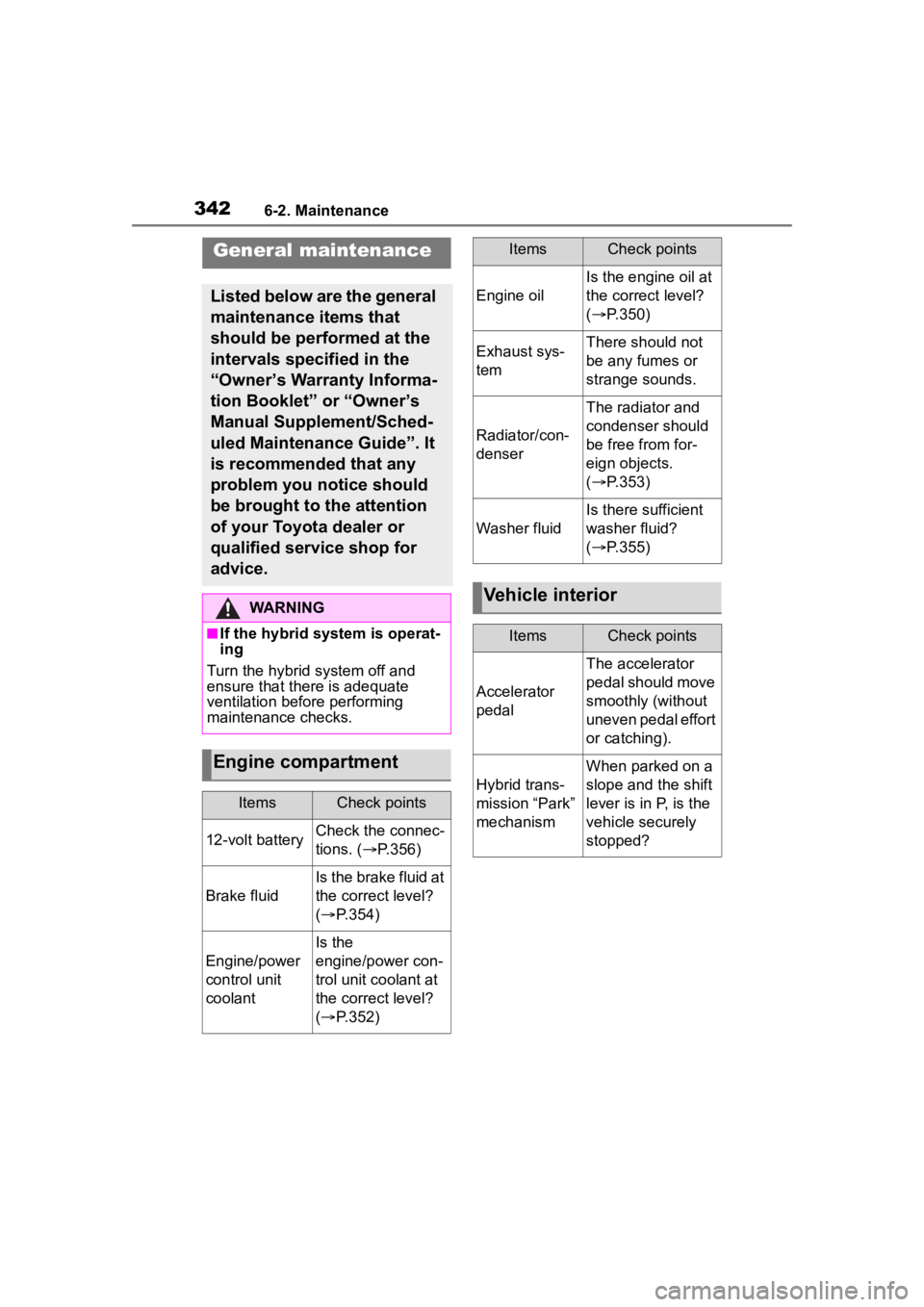
3426-2. Maintenance
General maintenance
Listed below are the general
maintenance items that
should be performed at the
intervals specified in the
ŌĆ£OwnerŌĆÖs Warranty Informa-
tion BookletŌĆØ or ŌĆ£OwnerŌĆÖs
Manual Supplement/Sched-
uled Maintenance GuideŌĆØ. It
is recommended that any
problem you notice should
be brought to the attention
of your Toyota dealer or
qualified service shop for
advice.
WARNING
Ō¢ĀIf the hybrid system is operat-
ing
Turn the hybrid system off and
ensure that there is adequate
ventilation before performing
maintenance checks.
Engine compartment
ItemsCheck points
12-volt batteryCheck the connec-
tions. ( ’é«P.356)
Brake fluid
Is the brake fluid at
the correct level?
(’é« P.354)
Engine/power
control unit
coolant
Is the
engine/power con-
trol unit coolant at
the correct level?
(’é« P.352)
Engine oil
Is the engine oil at
the correct level?
(’é« P.350)
Exhaust sys-
temThere should not
be any fumes or
strange sounds.
Radiator/con-
denser
The radiator and
condenser should
be free from for-
eign objects.
(’é« P.353)
Washer fluid
Is there sufficient
washer fluid?
(’é« P.355)
Vehicle interior
ItemsCheck points
Accelerator
pedal
The accelerator
pedal should move
smoothly (without
uneven pedal effort
or catching).
Hybrid trans-
mission ŌĆ£ParkŌĆØ
mechanism
When parked on a
slope and the shift
lever is in P, is the
vehicle securely
stopped?
ItemsCheck points
Page 347 of 516
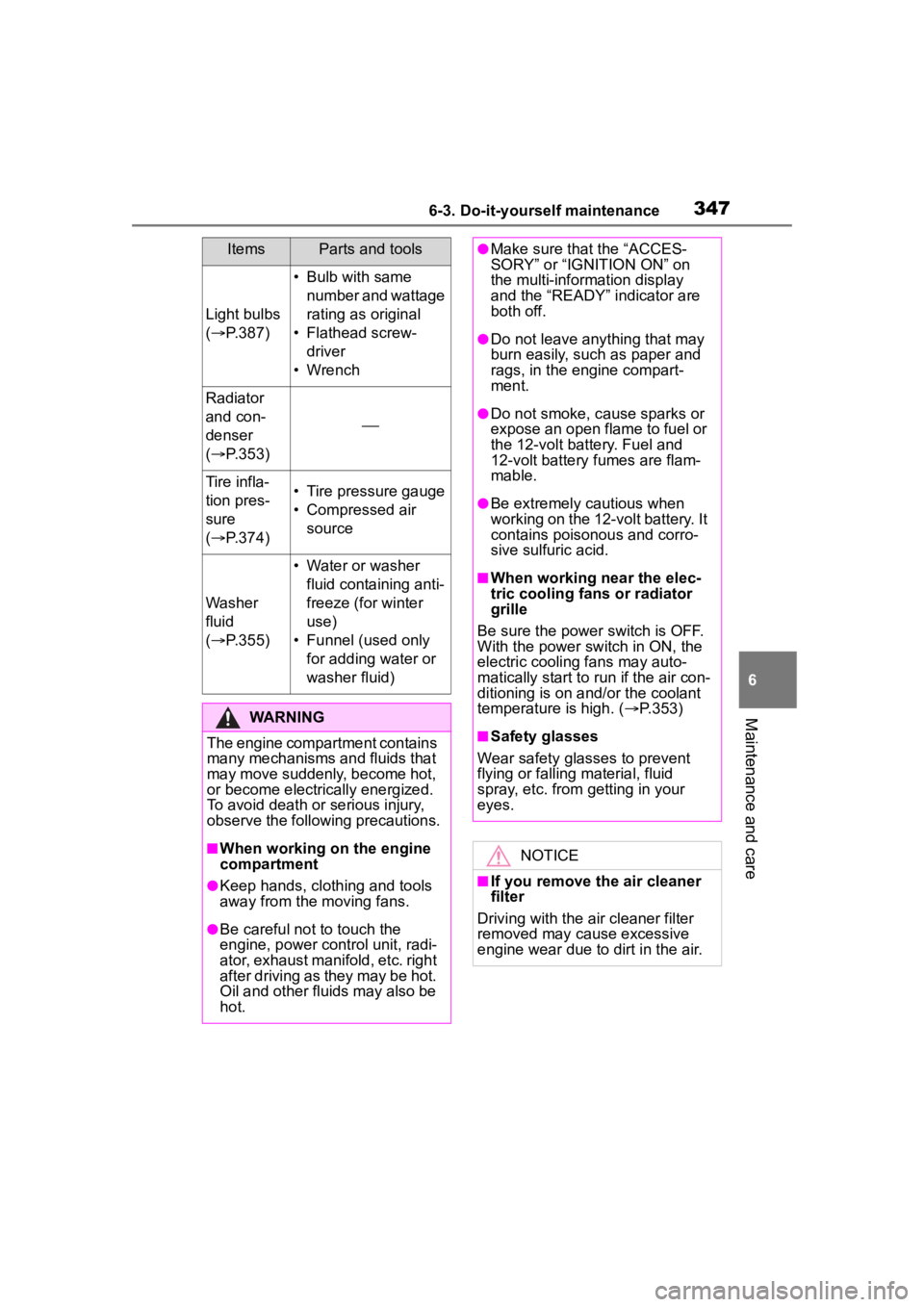
3476-3. Do-it-yourself maintenance
6
Maintenance and care
Light bulbs
(’é« P.387)
ŌĆó Bulb with same
number and wattage
rating as original
ŌĆó Flathead screw- driver
ŌĆó Wrench
Radiator
and con-
denser
( ’é« P.353)
’éŠ
Tire infla-
tion pres-
sure
(’é« P.374)ŌĆó Tire pressure gauge
ŌĆó Compressed air
source
Washer
fluid
(’é« P.355)
ŌĆó Water or washer
fluid containing anti-
freeze (for winter
use)
ŌĆó Funnel (used only for adding water or
washer fluid)
WARNING
The engine compartment contains
many mechanisms and fluids that
may move suddenly, become hot,
or become electrically energized.
To avoid death or serious injury,
observe the following precautions.
Ō¢ĀWhen working on the engine
compartment
ŌŚÅKeep hands, clothing and tools
away from the moving fans.
ŌŚÅBe careful not to touch the
engine, power control unit, radi-
ator, exhaust manifold, etc. right
after driving as they may be hot.
Oil and other fluids may also be
hot.
ItemsParts and toolsŌŚÅMake sure that the ŌĆ£ACCES-
SORYŌĆØ or ŌĆ£IGNITION ONŌĆØ on
the multi-information display
and the ŌĆ£READYŌĆØ indicator are
both off.
ŌŚÅDo not leave anything that may
burn easily, such as paper and
rags, in the engine compart-
ment.
ŌŚÅDo not smoke, cause sparks or
expose an open flame to fuel or
the 12-volt battery. Fuel and
12-volt battery fumes are flam-
mable.
ŌŚÅBe extremely cautious when
working on the 12-volt battery. It
contains poisonous and corro-
sive sulfuric acid.
Ō¢ĀWhen working near the elec-
tric cooling fans or radiator
grille
Be sure the power switch is OFF.
With the power switch in ON, the
electric cooling fans may auto-
matically start to r un if the air con-
ditioning is on an d/or the coolant
temperature is high. ( ’é«P.353)
Ō¢ĀSafety glasses
Wear safety glasses to prevent
flying or falling material, fluid
spray, etc. from getting in your
eyes.
NOTICE
Ō¢ĀIf you remove the air cleaner
filter
Driving with the air cleaner filter
removed may cause excessive
engine wear due to dirt in the air.
Page 350 of 516
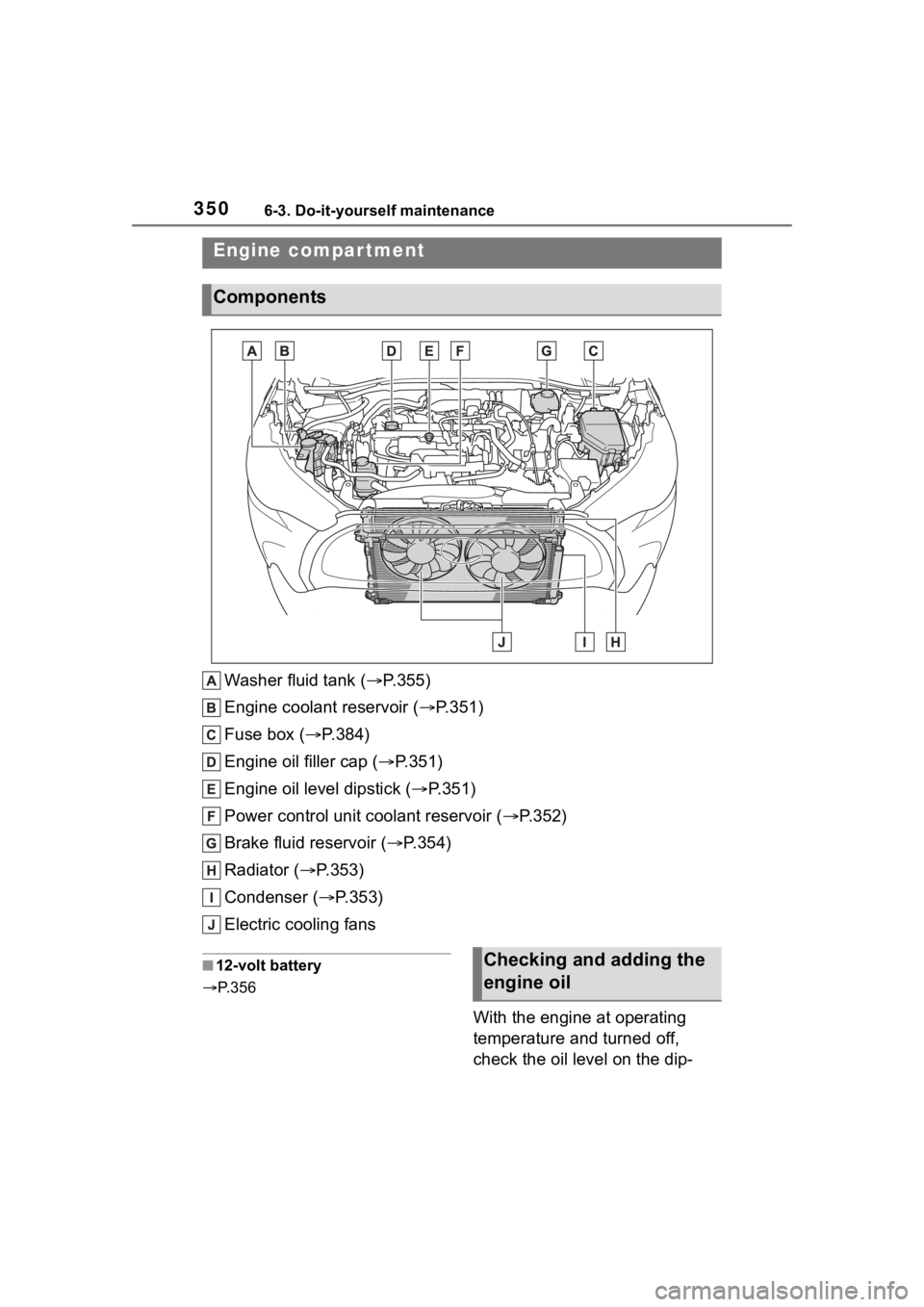
3506-3. Do-it-yourself maintenance
Washer fluid tank (’é« P.355)
Engine coolant reservoir ( ’é«P.351)
Fuse box (’é« P.384)
Engine oil filler cap (’é« P.351)
Engine oil level dipstick ( ’é«P.351)
Power control unit coolant reservoir ( ’é«P.352)
Brake fluid reservoir ( ’é«P.354)
Radiator (’é« P.353)
Condenser (’é« P.353)
Electric cooling fans
Ō¢Ā12-volt battery
’é« P. 3 5 6
With the engine at operating
temperature and turned off,
check the oil level on the dip-
Engine compar tment
Components
Checking and adding the
engine oil
Page 353 of 516

3536-3. Do-it-yourself maintenance
6
Maintenance and care
Ō¢ĀPower control unit coolant
reservoir
The coolant level is satisfactory
if it is between the ŌĆ£FŌĆØ and ŌĆ£LŌĆØ
lines on the reservoir when the
hybrid system is cold.
Reservoir cap
ŌĆ£FŌĆØ line
ŌĆ£LŌĆØ line
If the level is on or below the ŌĆ£LŌĆØ
line, add coolant up to the ŌĆ£FŌĆØ line.
(’é« P.438)
Ō¢ĀCoolant selection
Only use ŌĆ£Toyota Super Long Life
CoolantŌĆØ or a similar high quality
ethylene glycol based non-silicate,
non-amine, non-nitrite, and
non-borate coolant with long-life
hybrid organic acid technology.
U.S.A.:
ŌĆ£Toyota Super Long Life CoolantŌĆØ is
a mixture of 50% coolant and 50%
deionized water. (Minimum tem-
perature: -31┬░F [-35┬░C])
Canada:
ŌĆ£Toyota Super Long Life CoolantŌĆØ is
a mixture of 55% coolant and 45%
deionized water. (Minimum tem-
perature: -44┬░F [-42┬░C])
For more details about coolant, con-
tact your Toyota dealer.
Ō¢ĀIf the coolant level drops within
a short time of replenishing
Visually check the radiator, hoses,
engine/power control unit coolant
reservoir caps, drain cock and water
pump.
If you cannot find a leak, have your
Toyota dealer test the cap and
check for leaks in the cooling sys-
tem.
Check the radiator and con-
denser and clear away any for-
eign objects. If either of the
above parts is extremely dirty or
you are not sure of their condi-
tion, have your vehicle
WARNING
Ō¢ĀWhen the hybrid system is
hot
Do not remove the engine/power
control unit coolant reservoir
caps.
The cooling system may be under
pressure and may spray hot cool-
ant if the cap is removed, causing
serious injuries, such as burns.
NOTICE
Ō¢ĀWhen adding coolant
Coolant is neither plain water nor
straight antifreeze. The correct
mixture of water and antifreeze
must be used to provide proper
lubrication, corrosion protection
and cooling. Be sure to read the
antifreeze or coolant label.
Ō¢ĀIf you spill coolant
Be sure to wash it off with water to
prevent it from damaging parts or
paint.
Checking the radiator and
condenser
Page 438 of 516
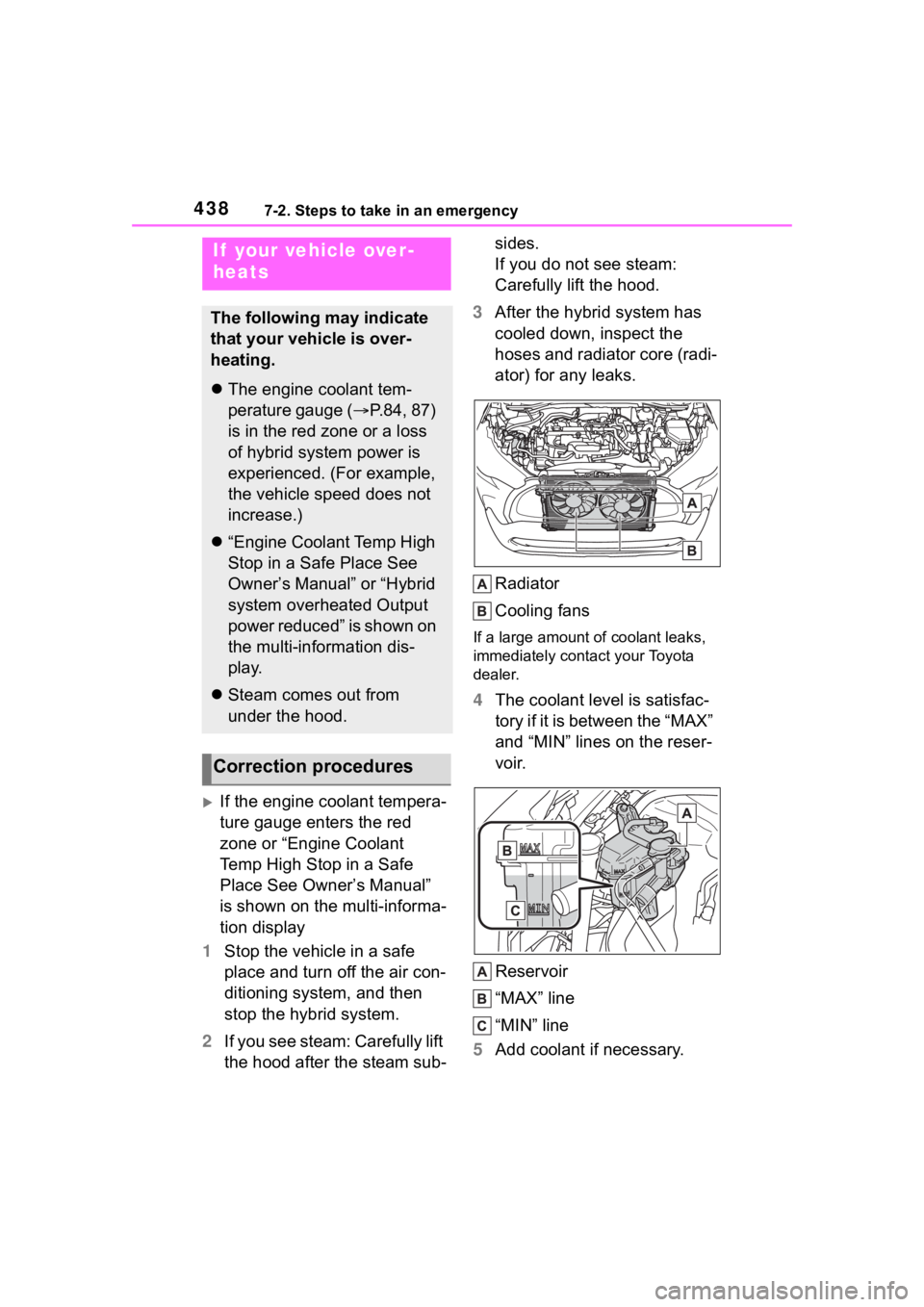
4387-2. Steps to take in an emergency
’üĄIf the engine coolant tempera-
ture gauge enters the red
zone or ŌĆ£Engine Coolant
Temp High Stop in a Safe
Place See OwnerŌĆÖs ManualŌĆØ
is shown on the multi-informa-
tion display
1 Stop the vehicle in a safe
place and turn off the air con-
ditioning system, and then
stop the hybrid system.
2 If you see steam: Carefully lift
the hood after the steam sub- sides.
If you do not see steam:
Carefully lift the hood.
3 After the hybrid system has
cooled down, inspect the
hoses and radiator core (radi-
ator) for any leaks.
Radiator
Cooling fans
If a large amount of coolant leaks,
immediately contact your Toyota
dealer.
4The coolant level is satisfac-
tory if it is between the ŌĆ£MAXŌĆØ
and ŌĆ£MINŌĆØ lines on the reser-
voir.
Reservoir
ŌĆ£MAXŌĆØ line
ŌĆ£MINŌĆØ line
5 Add coolant if necessary.
If your vehicle over-
heats
The following may indicate
that your vehicle is over-
heating.
’ü¼The engine coolant tem-
perature gauge (’é« P.84, 87)
is in the red zone or a loss
of hybrid system power is
experienced. (For example,
the vehicle speed does not
increase.)
’ü¼ ŌĆ£Engine Coolant Temp High
Stop in a Safe Place See
OwnerŌĆÖs ManualŌĆØ or ŌĆ£Hybrid
system overheated Output
power reducedŌĆØ is shown on
the multi-information dis-
play.
’ü¼ Steam comes out from
under the hood.
Correction procedures
Page 439 of 516
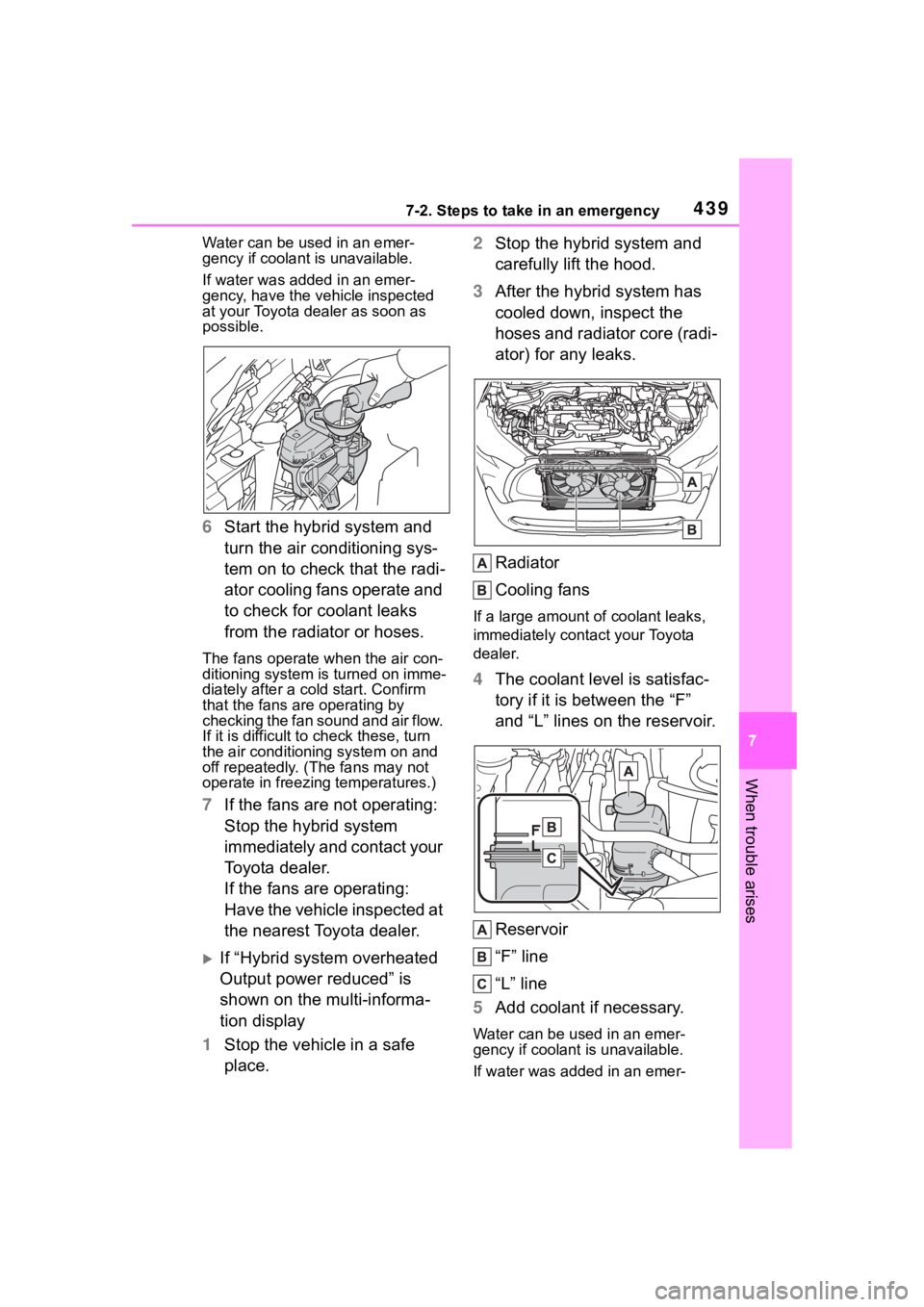
4397-2. Steps to take in an emergency
7
When trouble arises
Water can be used in an emer-
gency if coolant is unavailable.
If water was added in an emer-
gency, have the vehicle inspected
at your Toyota dealer as soon as
possible.
6Start the hybrid system and
turn the air conditioning sys-
tem on to check that the radi-
ator cooling fans operate and
to check for coolant leaks
from the radiator or hoses.
The fans operate w hen the air con-
ditioning system is turned on imme-
diately after a cold start. Confirm
that the fans are operating by
checking the fan sound and air flow.
If it is difficult to check these, turn
the air conditioning system on and
off repeatedly. (The fans may not
operate in freezing temperatures.)
7 If the fans are not operating:
Stop the hybrid system
immediately and contact your
Toyota dealer.
If the fans are operating:
Have the vehicle inspected at
the nearest Toyota dealer.
’üĄIf ŌĆ£Hybrid system overheated
Output power reducedŌĆØ is
shown on the multi-informa-
tion display
1 Stop the vehicle in a safe
place. 2
Stop the hybrid system and
carefully lift the hood.
3 After the hybrid system has
cooled down, inspect the
hoses and radiator core (radi-
ator) for any leaks.
Radiator
Cooling fans
If a large amount of coolant leaks,
immediately contact your Toyota
dealer.
4The coolant level is satisfac-
tory if it is between the ŌĆ£FŌĆØ
and ŌĆ£LŌĆØ lines on the reservoir.
Reservoir
ŌĆ£FŌĆØ line
ŌĆ£LŌĆØ line
5 Add coolant if necessary.
Water can be used in an emer-
gency if coolant is unavailable.
If water was added in an emer-
Page 440 of 516
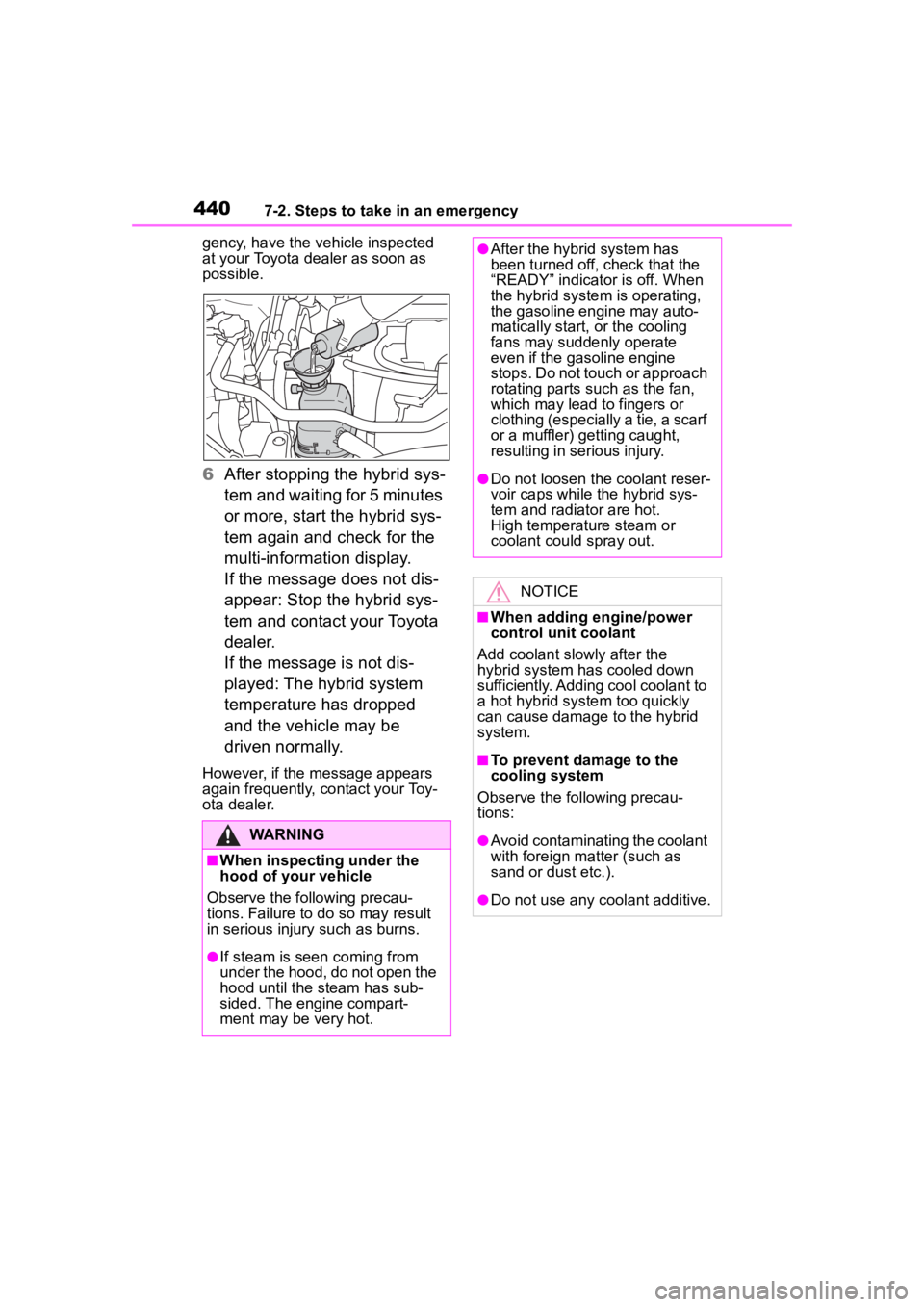
4407-2. Steps to take in an emergency
gency, have the vehicle inspected
at your Toyota dealer as soon as
possible.
6After stopping the hybrid sys-
tem and waiting for 5 minutes
or more, start the hybrid sys-
tem again and check for the
multi-information display.
If the message does not dis-
appear: Stop the hybrid sys-
tem and contact your Toyota
dealer.
If the message is not dis-
played: The hybrid system
temperature has dropped
and the vehicle may be
driven normally.
However, if the message appears
again frequently, contact your Toy-
ota dealer.
WARNING
Ō¢ĀWhen inspecting under the
hood of your vehicle
Observe the following precau-
tions. Failure to do so may result
in serious injury such as burns.
ŌŚÅIf steam is seen coming from
under the hood, do not open the
hood until the steam has sub-
sided. The engine compart-
ment may be very hot.
ŌŚÅAfter the hybrid system has
been turned off , check that the
ŌĆ£READYŌĆØ indicator is off. When
the hybrid system is operating,
the gasoline engine may auto-
matically start, or the cooling
fans may suddenly operate
even if the gasoline engine
stops. Do not touch or approach
rotating parts such as the fan,
which may lead to fingers or
clothing (especially a tie, a scarf
or a muffler) getting caught,
resulting in serious injury.
ŌŚÅDo not loosen the coolant reser-
voir caps while the hybrid sys-
tem and radiator are hot.
High temperature steam or
coolant could spray out.
NOTICE
Ō¢ĀWhen adding engine/power
control unit coolant
Add coolant slowly after the
hybrid system has cooled down
sufficiently. Adding cool coolant to
a hot hybrid system too quickly
can cause damage to the hybrid
system.
Ō¢ĀTo prevent damage to the
cooling system
Observe the following precau-
tions:
ŌŚÅAvoid contaminating the coolant
with foreign matter (such as
sand or dust etc.).
ŌŚÅDo not use any coolant additive.
Page 496 of 516

496Alphabetical Index
O
Odometer ............................ 85, 89
Odometer and trip meter displayDisplay change button...... 85, 89
Display items .................... 86, 89
Oil Engine oil ............................. 446
Rear differential oil ............... 448
Open tray ................................ 312
Opener Back door ..................... 122, 123
Fuel filler door ...................... 202
Hood..................................... 348
Outside rear view mirrors Adjustment ........................... 142
BSM (Blind Spot Monitor)..... 252
Folding ................................. 142
Outside rear view mirror defog-gers .................................... 301
RCTA function ...................... 257
Safe Exit Assist .................... 263
Outside temperature .......... 84, 87
Overheating ............................ 438
P
Paddle shift switches ............. 183
Panic mode ............................. 114
Parking assist sensors (intuitive parking assist) ...................... 268
Parking brake Operation ............................. 186
Parking brake engaged warning buzzer ................................ 188
Warning light ........................ 408
Warning message ................ 188
Parking lights Light switch .......................... 192
Replacing light bulbs ............ 387
Wattage ................................ 450 Parking Support Brake function
(for rear-crossing vehicles) .281Function................................281
Parking Support Brake function (static objects) ......................279Function................................279
PCS (Pre-Collision System) Function................................213
Warning light.........................407
Personal lights ........................308
PKSB (Parking Support Brake) ...............................................274
Power control unit ....................71
Power control unit coolant Checking ..............................352
Preparing and checking before winter ..................................291
Power outlet ............................316
Power steering (Electric power steering system) ...................285Warning light.........................405
Power switch...........................174 Changing the power switch modes.................................177
Power windows Door lock linked window opera-tion......................................144
Jam protection function ........143
Operation..............................143
Window lock switch ..............145
Pre-Collision System (PCS) Function................................213
Warning light.........................407
R
Radiator ...................................353
RCTAFunction................................257
RCTA function .........................258
Rear Cross Traffic Alert (RCTA) ...............................................257